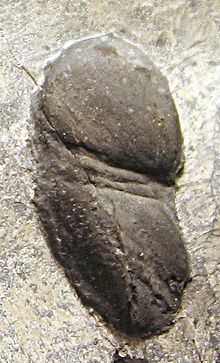Species T. arrusensis Rank Genus | ||
 | ||
Similar Buenaspis, Misszhouia, Naraoiidae, Tegopelte, Aglaspis | ||
Tariccoia is a genus of small to average size (between 2.5 centimetres (0.98 in) and 6 centimetres (2.4 in) long) marine arthropods in the Liwiidae Family, that lived during the late Ordovician period. Fossil remains of Tariccoia were collected from Sardinia, Italy. Tariccoia looks like a large, soft agnostid trilobite. It has a headshield (or cephalon) wider than the tailshield (pygidium), and in between them three (or four?) thoracic body segments (somites). The genus is monotypic, its sole species being Tariccoia arrusensis.
Contents
Etymology
The name of the genus references the Sardinian paleontologist M. Taricco. The species was named after the Riu is Arrus Member, the deposit in which it was found.
Description
Tariccoia arrusensis is between 2.5 and 6 cm along the axis, almost half a wide as long. The dorsal exoskeleton consists of a cephalon, a pygidium and two or three thoracic somites with articulating half-rings, all non-calcified. The cephalon is sub-semicircular, widest near the rounded genal angles. The cephalon is wider than the pygidium. Eyes are absent. Antennas are not known. The body is constricted at the two or three thoracic somites, so the animal gives the impression to have a waist. The pygidium is widest before midlength. The pygidium has a mid-ridge.
Differences with other Liwiidae
Distribution
T. arrusensis has been collected from the Upper Ordovician (Sandbian to Katian) Riu is Arrus Member, Monte Argentu Formation, Sardinia, Italy.
Habitat
Tariccoia arrusensis was probably a marine bottom dweller.
